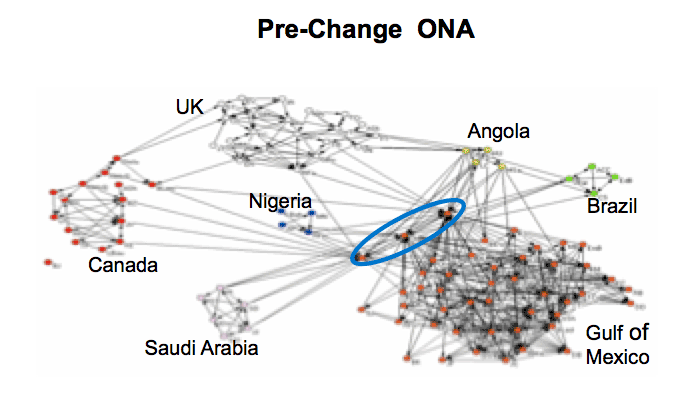It’s well known that organizations fail at change more often than they succeed. Despite enormous attention paid to understanding change processes, neither traditional practices nor cutting-edge thinking has provided leaders what they need to enact large-scale, significant change.
One thing we do know is that leaders cannot rely on formal organizational channels to drive change in today’s hyper-connected, fast-moving world. They are too slow and inefficient.
A more effective approach is to use the existing, but hidden, networks in the organization. Networks that naturally grow out of the interactions between people and groups are relationship based, not authority based. If these networks are made visible, understood and activated, they are fast, efficient systems for change.
Identify 3 types of network influencers.
Using organizational network analysis (ONA), we can identify people who play three roles in the network: connectors, brokers and energizers. These roles are not assigned and don’t show up on an organization chart, but they hold the keys to more successful organizational change.

1. Central connectors
Central connectors are well connected, typically with many ties within a team, function, geography, capability or demographic. They are credible and respected opinion leaders in their groups, and so can rapidly engage organize others to accept new ideas and streamline implementation. Connectors create alignment within a group through their informal leadership and trusted opinions.
ONA helps us identify these employees, 50% of whom, for one reason or another, are not generally on leaders’ radar screens. Leaders want to tap these people as part of their change planning, implementation and communication efforts—but they must be careful not to over-burden them. By virtue of their position in the network, many central connectors are overloaded with collaborative work and colleagues’ requests. The key to successful change is to leverage first- and second-order central connectors to drive change while not overloading the network.
2. Brokers
Brokers, also called boundary spanners, are important in the network not because of the number of people they are connected to, but because of the number of relationships they hold that bridge organizational boundaries. They act as critical conduits of information and are very effective in bringing people and groups together around a common interest or idea.
Brokers live in the white space of the organization—and so are often unrecognized without a network analysis. While leaders are often only about 50% correct in identifying the central connectors without ONA, they are only about 30% accurate with the brokers. This is a substantial loss because brokers understand the concerns and views of various groups and are trusted liaisons among them. They are critical to crafting design and implementation plans that address diverse needs and interests. They are also the most natural conduit for efficient communication to the rest of the organization and are often lead adopters or ambassadors of a change.
3. Energizers
Energizers are critical to change efforts because they enthusiastically adopt and promote new ideas and processes. Their enthusiasm is contagious, inspiring others to get involved, share fledgling perspectives or even speak up about concerns. They are vital to the process of gaining acceptance by those implementing or affected by a change.
ONA often reveals a small number of people that are extremely important in generating enthusiasm across a large number of colleagues. It can also help us see their darker counterparts—those that drain energy in different ways and whom leaders often also want to engage early to help stop projects from dying the death of one thousand cuts. When energizers support a change and de-energizers get on board, they help overcome resistance by demonstrating optimism, seeing the glass as half full and urging others to appreciate the positive effects of a change. Engaging these energizers ensures that the organization unleashes latent passion—rather than grudging compliance—deep in the workforce.
Activate networks of influencers.
When leaders use network analysis to identify the influencers, they can create targeted design and implementation processes that are far more efficient in driving organizational change. We’ve found that selecting these opinion leaders often enables leaders to rapidly touch 60-70% of the population whereas driving the same process through the hierarchy only touches 30-35%. Unearthing and engaging these opinion leaders makes change efforts much more efficient and effective.
Consider a well-known petrochemical company’s efforts to promote best-practice transfer in a series of communities of practice. Due to the high, fixed-asset cost structure, there were significant savings to be attained through the movement of ideas in these groups that preserved machine uptime or optimized throughput. Yet their traditional efforts to promote sharing within the network—a knowledge management system and roles designed to facilitate transfer of best practices—had not produced results.
Here the organization used ONA across all of the communities to identify central connectors, brokers and energizers and put in place strategies for engaging them in each community (see below for example of one of these groups).

With this information, the organization took several actions, including:
- Re-defined the roles of three central people involved in critical knowledge transfer work (circled in blue).
- Created two-week rotation programs to connect central people in different geographies.
- Revised project funding and approval to ensure that recipients had engaged central connectors and brokers before obtaining funds.
- Through energizers they introduced a collaborative tool to set up problem-solving forums and increase awareness of expertise.
- Improved mentoring and onboarding practices to draw in peripheral members. In particular, they tapped brokers and energizers to reach out to peripheral people in ways that pulled these people into the network in one third of the time it typically took.
The actions organizations can take are tailored to the specific group and the specific change—putting an end to cascading information campaigns as the primary strategy to drive change.
Compare networks before and after change efforts.
As changes are implemented and people across the organization adapt, a follow-up ONA can be done to evaluate success and identify areas where future efforts should focus.
Nine months after implementing the fairly simple and inexpensive ideas above, the petrochemical company conducted a follow-up network analysis, which clearly showed that value-added collaborations had improved. On average, people were able to connect much more efficiently due to better integration of the network (see graphic below). And importantly, these were interactions that were all generating measurable business value for the organization—not simply more meetings or emails.

By using the network to drive their change effort, this company saw significant business benefits that would not have been realized through the usual top-down, formal change processes:
- Lowered customer dissatisfaction by 24%
- Reduced cost of poor quality by 66%
- Increased new product revenue by 22%
- Improved operational productivity by more than 10%
It’s time to change the way we do change.
Assessing networks before a restructuring, strategic reorientation or launch of a significant initiative can improve uptake of a change and increase the odds of success. Network analytics can identify informal opinion leaders who can galvanize others around a plan and project—or derail success. By engaging influencers in key network positions, early on, leaders drive change quickly and more effectively.
Take a deeper look at the role of brokers, connectors and energizers in the article A Bridge Too Far: How Boundary Spanning Networks Drive Change and Effectiveness and explore the many ways network analysis can help organizations drive agility and alignment in the blog post, What is Organizational Network Analysis (ONA)? Or, learn more about working with Rob and his team to bring ONA to your change effort.





 Overloaded? Stop Blaming Your Boss
Overloaded? Stop Blaming Your Boss
 Rob Cross has studied the underlying network dynamics of effective organizations and the collaborative practices of high performers for more than 20 years. Through research and writing, speaking and consulting, and courses and tools, Rob’s network strategies are transforming the way people lead, work and live in a hyper-connected world.
Rob Cross has studied the underlying network dynamics of effective organizations and the collaborative practices of high performers for more than 20 years. Through research and writing, speaking and consulting, and courses and tools, Rob’s network strategies are transforming the way people lead, work and live in a hyper-connected world.